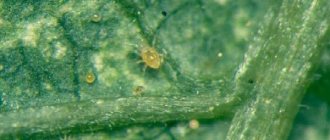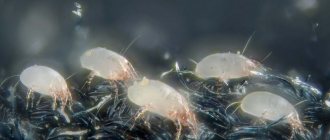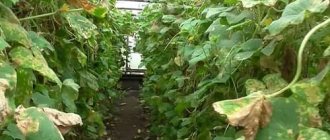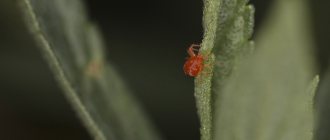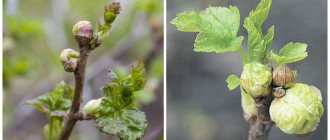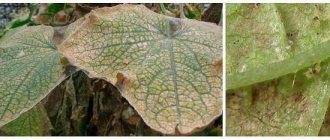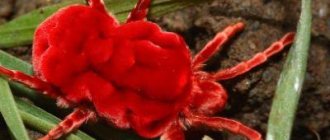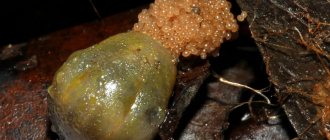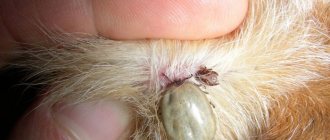- Description of the insect and its life cycle Varroa mite - description of females and males
- Life cycle of an insect
- Pericin for varroa mites
- Drone brood cutting
- Pine flour
The varroa mite is a small insect, no more than 2 mm in size, that is the causative agent of a serious disease in bee colonies and a carrier of various infections. Previously, because of this pest, beekeepers had to burn apiaries, but in recent decades, effective means of combating it have appeared. Let's look at how the parasite develops and how to counteract it.
Description of the insect and its life cycle
The varroa mite is an ectoparasite that lives on bees. The insect has a flat body with legs covered with hair and 4 pairs of legs, thanks to which it moves and clings to the bee.
Varroa mite - description of females and males
Females are colored dark brown, their size is 2 mm. The mouthparts are hidden under the body and have a piercing-sucking appearance. The females use it to pierce the bee’s shell and feed on its blood.
Female varroa mites have the following morphological structure:
- they have a movable peritremal tube, thanks to which breathing is regulated in different living conditions;
- the specific shape of the body allows it to be firmly held on the bee’s body;
- with small teeth on the chelicerae, the females are firmly kept from falling out of the bee's wound;
- the springy cover prevents the females from sticking to the sticky substance.
Male varroa mites are smaller and have a round body shape. Their bodies are painted in white and gray tones with an inconspicuous yellow tint. The oral apparatus of males is designed to pump semen during fertilization of females. The ends of their legs are crowned with suction cups.
Life cycle of an insect
The entire life cycle of these arachnid representatives consists of the following stages:
- The females move from the bee to the honeycomb and climb into the cell with the bee larva until it is sealed. 3 days after the cell is sealed, the female begins laying eggs. Usually there are 5 eggs in a clutch, half a millimeter long.
- The eggs hatch into larvae, which soon turn into nymphs. Nymphs are equipped with 4 pairs of legs. The nymphs molt and enter the next stage, the deutonymph. They feed on the hemolymph of bees.
- Males, staying in cells, fertilize young females, then their mission is considered completed, and they die of hunger. In this regard, only females parasitize bees.
- Young bees, having completed their development, are selected from the cells. At the same time, the cells are left by mites. They climb onto bees or drones, where they remain until the next oviposition.
The entire life cycle, which starts from the moment the egg is laid and ends with the appearance of an adult (imago), lasts from 8 to 11 days for females, and 9 days for males. In summer, the life expectancy of females is no more than 120 days, and in winter – almost 150 days.
In winter, there is no bee brood, so mites do not reproduce, and every tenth of them dies. However, with the onset of spring, their number begins to increase sharply and can increase 20 times.
At +24 degrees, female varroa can live without food for almost a week. When the temperature drops, the varroa mite stops breathing and hides in the cells of the honeycomb. It becomes difficult to destroy it.
Typically, 4-5 parasites are attached to a worker bee, 8 female mites are parasitizing on drones, and up to 20 can be counted on bee and drone pupae.
Braulez
Another parasite that negatively affects the life of bees is the bee louse. This is an outdoor insect whose name is braula. Braulosis is a disease that causes weakening and decreased productivity of the entire family. The bee louse is somewhat similar in appearance to the varroa mite. It also lives on the chest or belly of bees. Braula eats honey from the bee's lips, and the bees' nutrition is disrupted and they begin to weaken.
The appearance of braulez
Braula is a bee louse.
wax
A brawl can get into a hive in several ways, the main of which are by adding infected frames with dry land, strengthening weak colonies, and replacing the queen. These parasites easily move from sick bees to healthy ones. Thanks to their mobility, they can infect an entire healthy family in a short time.
The main signs of braulosis
- The presence of small dots on the body of bees is called brawls. Their number on a worker bee can be from two to ten pieces, but on the queen bee - up to one hundred pieces.
- Decreased performance of bees
- If the brawls are located on the uterus, it begins to behave slowly and the ability to lay eggs is impaired
The main threat the brawls pose is to the queens, as they often lead to their death.
How does infection occur?
Infection of bees with the varroa mite leads to a severe invasive disease of bees, their pupae and larvae, called varroatosis. This disease is a real scourge of the beekeeping industry and causes enormous damage to it.
In summer, the spread of mites from infected bees to healthy ones occurs in the following way:
- wandering bees;
- thieving bees;
- when removing apiaries;
- during swarming of bees;
- when purchasing bees and queens;
- when introducing infected brood into families;
- when infected bees come into contact with healthy ones, during pollination of flowers;
- due to improper storage of drone brood.
Varroa can spread at a speed of 10 km per quarter, and this depends on the presence of apiaries in the vicinity. It has been noted that in regions with a hot climate, varroatosis spreads faster.
What am I doing
I use small/natural honeycomb cells and mesh trays in the hives and monitor for mites using a white sheet in the tray. As long as the mites are under control, and from 2002 to this day they have been, that's all I do. If suddenly the number of mites increases while the stores are installed, I will probably fumigate the hive with edible mineral oil or spray powdered sugar. If after collecting the honey the number of mites does not decrease, I will treat the hive with oxalic acid vapor. However, I haven't needed any of this since my bees have regressed to their natural cell size. Therefore, the use of small cells is quite effective for me against both types of mites and is suitable for normal conditions.
Symptoms of infection
After a bee colony is infected with varroa, the disease occurs without visible signs for the first 2 years. In the third year, the number of mites increases sharply and they infect a third of the bees in the hive.
Affected bees and drones have characteristic deficiencies:
- they have no or incompletely developed wings and legs;
- the bees' body is deformed;
- the brood is variegated;
- by autumn the number of bees sharply decreases;
- During the wintering process, bees do not behave calmly;
- the bottom of the hive is covered with dead bees, on which parasites are visible;
- heavily infected colonies may leave the hive after migrating.
Application of purchased acaricides
When using chemicals against ticks, you must adhere to the following recommendations:
Their use is strictly prohibited on the eve of honey collection or during the process. Neglecting this rule can result in dangerous toxins in the honey.
It is necessary to use only those drugs that are approved for treatments against varroa mites. Formic acid may only be used in the form of Illert tiles. Before using a chemical, you must carefully read the instructions.
The honeycombs that are in the hive at the time of processing cannot be used later, like honeycombs. They definitely need to be melted.
In the process of pumping out honey, you need to use a sieve to separate wax particles from the honey. The wax may contain pesticide residues.
Chemical-based products are used against ticks that kill them or severely damage them. Drugs can be fed to bees and affect the parasite through the blood.
In addition, they can evaporate in the hive and infect the pest through the respiratory system. Also, some drugs act through the contact of bees with them through the strips along which they move.
The following drugs are currently used:
Pericin for varroa mites
This chemical acts on the parasite through the bee's blood. It kills ticks that are on it. It is used in winter, when there is no brood. Usually 2 treatments are planned at intervals of a week, at temperatures close to zero.
A colony in a two-hull hive uses 30 ml of emulsion. Treatment is carried out with a spray bottle or syringe.
Apitol
This water-soluble drug easily penetrates honey, which requires careful use. The product powder should be dissolved in water and applied by spraying.
Formic acid on Illert tiles
The method is based on the evaporation of the product from the surface of the tile. Vapors of the drug penetrate into the hive with the air and affect mites through the respiratory system. Apply the chemical in the evening, with the taphole open, at a temperature of 12 to 20 degrees Celsius.
Such treatments can be planned 4 per season, with intervals between them of 15 days. For a single-hull hive, 1 tile is enough.
Cecafix against varroa mite
This drug is in many ways similar to pericin, but it is better tolerated by bees.
Bayvarol
The product is sold in the form of special strips, which should be hung along the inner perimeter of the hive. The product gets on the bees when they come into contact with the strips.
Using electric fields to combat bee varroa
The thermal method of influencing affected bees was analyzed and a conclusion was made about the prospects of its implementation in combination with the use of external electric fields. Based on an analysis of the selective influence of a microwave electromagnetic field on objects of different geometric sizes, the possibility of achieving a selective effect when heating bees and mites is shown. Taking into account the actual sizes of the objects being processed, it was determined that the maximum selectivity of the effect is achieved at a field frequency of 22...25 GHz. Since mites are located on the bodies of bees, they must be separated when exposed to an ultra-high-frequency electromagnetic field. For this, it is proposed to use a second electric field with a frequency of 450...550 Hz. Low-frequency exposure leads bees to a state of increased motor activity, accompanied by temporary separation of mites.
The technical implementation of the method of combating varroa is proposed to be carried out using an ultra-high-frequency generator, the output signals of which are modulated by low-frequency oscillations in amplitude.
Exposure to the low-frequency component of the electric field of an amplitude-modulated signal with a frequency of 450...550 Hz causes a rapid increase in the motor activity of bees, and the subsequent destruction of mites is achieved by the influence of the high-frequency component. It has been experimentally established that there are no negative consequences when bees are exposed to electric field energy for 10...15 minutes.
When the treatment was repeated many times, no habituation effect was observed. The described method can be used to combat other tick-borne diseases of bees.
To effectively combat varroa, the new method uses two electrophysical factors simultaneously: a low-frequency component of the electric field (with a frequency of 450...550 Hz) and a high-frequency component (with a frequency of 22.7...25.5 GHz). In this case, the electric field strength should not exceed 200 V/cm and be in the range of 50...180 V/cm. The energy of the low-frequency (low-frequency component) field excites the bees, increases their motor activity and causes the mites to be shaken off, and the energy of the high-frequency (high-frequency component) field selectively affects the mites, causing their intense heating and death.
Biotechnical measures against varroa mite
The essence of this negative impact on ticks lies in human intervention in the course of their biological development. The list of such events includes:
Drone brood cutting
Female mites often lay eggs in honeycomb cells containing drone brood. If you cut it out and then destroy it, you can reduce the number of parasites. This work should be planned for the junction of March and April.
Destruction of a honeycomb trap with a queen locked in it
According to this method, the queen is placed 3 times in turn for 10 days on an empty honeycomb in a frame. The queen begins to worm and soon does not remain outside the cage with the open brood queen.
Female mites crawl onto the open brood of honeycomb traps to reproduce. All that remains is to freeze it in order to destroy the individual.
Heat treatment
The trap honeycombs or all the honeycombs with brood are heated to a temperature level at which the mites die, but the bees still survive. This method is considered quite effective, but very labor-intensive.
Features of celandine preparation
It is important to prepare celandine for ascosferosis correctly. It is important to collect such a crop from June to July, that is, during the process of its active flowering
You can find such a plant in places that have not been subjected to agricultural cultivation for a long time. For example, next to fences, on arable land, outside villages.
It is important to remember that such a culture is poisonous. When collecting it, you need to use gloves, especially if a person has allergic reactions.
When preparing, it is important to remember to observe two aspects of preparation:
- air temperature indicator - the warmer it is outside, the faster the crop can be dried;
- humidity indicator - if its level is excessive, such a plant does not dry out, but turns black (such material is prohibited from being used for treatment).
In order for the crop to dry quickly and correctly, its stems should first be cut into small pieces. The raw materials are dried outside under a canopy and mixed from time to time. The thickness of the drying layer should not exceed 4-5 centimeters.
Folk remedies for varroa mites
Along with chemicals, folk remedies are successfully used in the fight against varroa mites. The most popular herbal preparation is Varrabraulin. This environmentally friendly and safe product is used at the rate of 4 g per frame.
In addition, the following recipes are widely used:
Pine flour
The recipe is prepared and used as follows:
- take any needles;
- dry the material;
- grind the needles into powder;
- sprinkle the beehives with powder three times, at intervals of a week, at the rate of 50 g per family;
- After contact with the powder, the varroa mite will no longer be able to attach itself to the victim.
Dill oil for varroa mites
The recipe is prepared according to the following algorithm:
- take 2 cups of crushed dill seeds;
- mix the powder with 100 g of sunflower oil;
- the composition is heated in a water bath for 2 hours;
- leave the composition for 22 hours;
- squeeze out the composition and spread it on a piece of plastic film measuring 30 by 20 cm;
- the film with the smeared side is placed on the frame, and on top of it is placed the same piece of film with the smeared side facing up;
- after a week this procedure should be repeated.
Horseradish
Dried horseradish roots are placed in a smoker along with other flammable material. Then the hives affected by the mite are thoroughly treated with smoke.
Features of the fight against the disease
Treatment of ascospherosis with garlic is considered a fairly effective and common procedure. In spring, you can use all parts of the crop (shoots, shoots and heads):
- Well-mashed garlic arrows are placed on the bottom of the hive, and its head, minced in a meat grinder, is placed in gauze, tied and attached to frames under canvas (use several tablespoons for each frame). Garlic should be changed every 5-6 days until the infection is completely eliminated and the condition of the bees is normalized.
- To prepare fertilizer for the treatment of ascosferosis with garlic, garlic pulp is diluted in warm sugar syrup, which is consumed by bees, in a ratio of several cloves per 500 ml. For one nest you should use 100-150 grams of the finished product. The second feeding is carried out after 5 days.
The medicinal properties of horsetail will help well in the treatment of ascospherosis of bees. This product is prepared from fresh panicles of the crop, which contain the largest amount of silicic acid. The grass is placed in the pan by eye. The product is placed on the fire and continued to boil for 10 minutes, removed from the heat and left for several hours. The finished broth is added to the syrup (ratio 1 to 1), which is then allowed to be consumed by the bees for five days, one liter per nest. The medicinal properties of horsetail help to actively combat infection, cure sick bees and avoid further spread of the disease.
Fresh wormwood and tansy line the canvases. For one hive you need to prepare 200-250 grams of the drug
After the stems wilt, it is important to replace them with a portion of new grass. The product is used during the active period of bee life, excluding honey collection
Treatment of ascospherosis with yarrow is carried out using the so-called dusting of honeycombs with plant powder. To achieve a good therapeutic effect, you should use pharmaceutical packaging of yarrow or dried plants, prepared in the spring. Approximately five pinches of powder should be used per hive. The procedure is carried out three times with a break of three days. After the third treatment, the symptoms of the disease subside.
Treating the hive with vinegar against ascospherosis is also quite effective. 9% food vinegar should be diluted with hot water in a one to one ratio. This vinegar mixture can also be prepared from acetic acid, having previously calculated the appropriate proportion depending on its concentration.
Preventative measures for the appearance of varroa mites
To protect your bees from varroa, you need to plan and implement a range of preventive measures. Here is a list of the most important of them:
- if you have purchased a bee family or caught a swarm of bees, treat them with pericin;
- regularly inspect the hive tray and drone brood, trying to detect the parasite at the earliest stage of infection;
- It is advisable to carry out anti-mite treatments simultaneously with beekeepers who have their hives nearby;
- Clean and disinfect hives regularly.
The varroa mite is one of the most insidious parasites that can significantly reduce honey production in an apiary. Nowadays, the beekeeper has many methods and options for its destruction.
You just need to develop your own strategy to combat the parasite, which would be combined with the design of the hives, climatic conditions, food supply and technology for keeping bees.
Prevention measures
To reduce the harm caused by the varroa mite, various preventive measures should be taken:
- Acquired families and captured swarms must be treated at least once (for example, the swarm with pericin, and the rest with formic acid). Based on the number of parasites on the pallet, a decision is made about the need for further treatment.
- Regular inspections of the tray and drone brood should be carried out for the presence of parasites.
- It is extremely important to coordinate treatment against varroa with neighboring beekeeping farms to obtain a good result and to avoid re-infestation.
- Apply control methods regularly, and do not miss the periods most suitable for their implementation.
- Periodic cleaning and disinfection is required. Following normal hygiene rules will help protect you from mixed diseases.
- It is necessary to reheat the honeycombs in a timely manner.
The characteristics of the varroa mite, analysis of mites on larvae and adult bees, treatment methods, medications to combat the pest and the time of their use are described in detail in the video:
Varroa mites are dangerous pests that cause a fatal disease that causes serious complications in the apiary. However, today there are a large number of ways to both combat attacking parasites and prevent their appearance and spread.
0
1
Copy link
